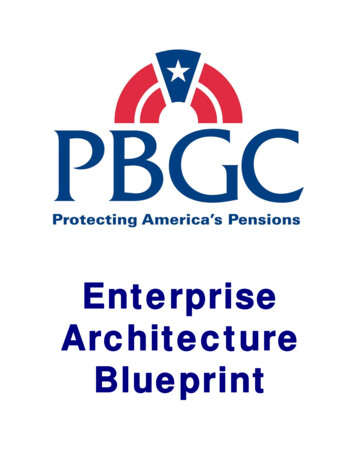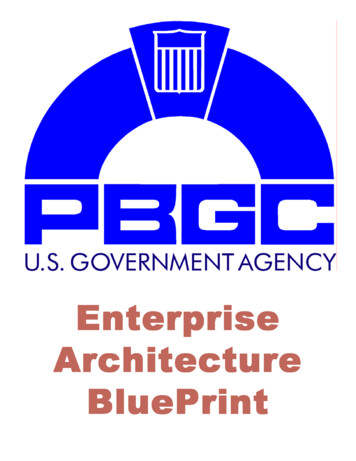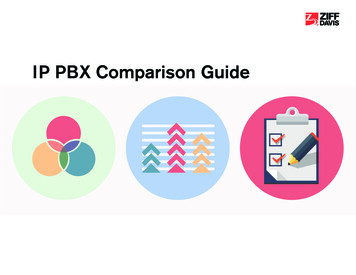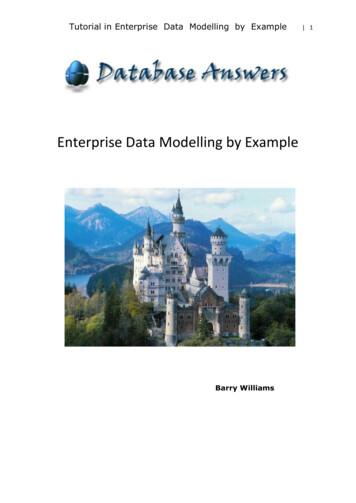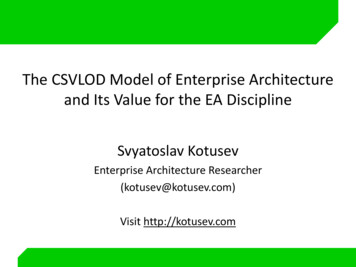
Transcription
The CSVLOD Model of Enterprise Architectureand Its Value for the EA DisciplineSvyatoslav KotusevEnterprise Architecture Researcher(kotusev@kotusev.com)Visit http://kotusev.com
What Is Enterprise Architecture?What components constitute enterprise architecture?Two conceptualizations of enterprise architecturecurrently dominate in the EA discourse: Enterprise architecture as business architecture, dataarchitecture, application architecture and technologyarchitecture Enterprise architecture as the current state, futurestate and transition roadmapSvyatoslav Kotusev (kotusev@kotusev.com) for the British Computer Society (BCS)2
EA as Four ArchitecturesEnterprise architecture consists of four components: Business (or organization) architecture Data (or information) architecture Application (or system) architecture Technology (or infrastructure) architectureFour “layers” of enterprise architecture, or BDAT stackSvyatoslav Kotusev (kotusev@kotusev.com) for the British Computer Society (BCS)3
EA as Four ArchitecturesEnterprise ArchitectureBusiness ArchitectureData ArchitectureApplication ArchitectureTechnology ArchitectureSvyatoslav Kotusev (kotusev@kotusev.com) for the British Computer Society (BCS)4
Associated ProblemsProblems with understanding enterprise architecture asfour separate architectures: No clear-cut architectures, e.g. EA artifacts candescribe many layers simultaneously Low explanatory power, e.g. what are the usagescenarios or stakeholders of data architecture? Largely self-serving, e.g. same as classifying EAartifacts into black-and-white and colored Other domains can be also described in EA artifactsSvyatoslav Kotusev (kotusev@kotusev.com) for the British Computer Society (BCS)5
Overall AdequacyThinking about enterprise architecture as four separatearchitectures is inadequateThinking about enterprise architecture in this wayresembles thinking about cars as a mix of metal, plastic,glass and rubber, i.e. true but uselessSvyatoslav Kotusev (kotusev@kotusev.com) for the British Computer Society (BCS)6
EA as Two States and RoadmapEnterprise architecture consists of three components: Current (baseline, as-is, existing, etc.) state Future (target, to-be, desired, etc.) state Roadmap (or transition plan)Two states, gap analysis, getting from “here” to “there”Svyatoslav Kotusev (kotusev@kotusev.com) for the British Computer Society (BCS)7
EA as Two States and RoadmapEnterprise av Kotusev (kotusev@kotusev.com) for the British Computer Society (BCS)8
Associated ProblemsProblems with understanding enterprise architecture asthe current state, future state and roadmap: In most cases the long-term future state for thewhole enterprise is not (and even cannot be) defined There may be many future states for different scopes(business department, change program, etc.) andplanning horizons (e.g. 1, 2, 3 and 5 years) Simplistic model, does not reflect full complexity Organizations cannot be engineered mechanisticallySvyatoslav Kotusev (kotusev@kotusev.com) for the British Computer Society (BCS)9
Overall AdequacyThinking about enterprise architecture as the currentstate, future state and roadmap is inadequateThinking about enterprise architecture in this way is amisguiding simplification of the organizational realitySvyatoslav Kotusev (kotusev@kotusev.com) for the British Computer Society (BCS)10
Current Situation with EACurrent situation in the EA discipline: Both popular conceptualizations of enterprisearchitecture are inadequate No alternative evidence-based conceptualizationsexists It is not clear what components constitute enterprisearchitecture For many years the phenomenon of enterprisearchitecture has no meaningful explanationSvyatoslav Kotusev (kotusev@kotusev.com) for the British Computer Society (BCS)11
Introducing the CSVLOD ModelThe CSVLOD model is a novel conceptualization ofenterprise architecture from scratch that: Emerged from research, not from marketing Supported by evidence from real organizations Reflects genuine industry EA best practices Accurately describes empirical realities of EA Fills the critical gap in the EA disciplineSvyatoslav Kotusev (kotusev@kotusev.com) for the British Computer Society (BCS)12
IT-FocusedBusiness-FocusedCSVLOD Taxonomy for nsOutlinesGlobal conceptualrules and fundamentalconsiderationsimportant for businessand relevant for ITHigh-level conceptualdescriptions of anorganization from thebusiness perspectiveHigh-level descriptionsof separate IT initiativesunderstandable tobusiness leadersStandardsLandscapesDesignsGlobal technical rules,standards, patternsand best practicesrelevant for IT systemsHigh-level technicaldescriptions of theorganizational ITlandscapeDetailed technical andfunctional descriptionsof separate IT projectsactionable for projectteamsSvyatoslav Kotusev (kotusev@kotusev.com) for the British Computer Society (BCS)13
CSVLOD Model of plicationsSvyatoslav Kotusev (kotusev@kotusev.com) for the British Computer Society reDataApplicationsInfrastructureEnterprise Architecture14
Considerations EA ArtifactsConsiderations are Business-Focused RulesPrinciplesPoliciesSvyatoslav Kotusev (kotusev@kotusev.com) for the British Computer Society (BCS)15
Standards EA ArtifactsStandards are IT-Focused RulesTechnology Reference ModelsGuidelinesSvyatoslav Kotusev (kotusev@kotusev.com) for the British Computer Society (BCS)16
Visions EA ArtifactsVisions are Business-Focused StructuresBusiness Capability ModelsRoadmapsSvyatoslav Kotusev (kotusev@kotusev.com) for the British Computer Society (BCS)17
Landscapes EA ArtifactsLandscapes are IT-Focused StructuresLandscape DiagramsInventoriesSvyatoslav Kotusev (kotusev@kotusev.com) for the British Computer Society (BCS)18
Outlines EA ArtifactsOutlines are Business-Focused ChangesSolution OverviewsOptions AssessmentsSvyatoslav Kotusev (kotusev@kotusev.com) for the British Computer Society (BCS)19
Designs EA ArtifactsDesigns are IT-Focused ChangesSolution DesignsPreliminary Solution DesignsSvyatoslav Kotusev (kotusev@kotusev.com) for the British Computer Society (BCS)20
IT-FocusedBusiness-FocusedUsage of EA nsOutlinesDeveloped collaborativelyby senior business leadersand architects and thenused to influence allarchitectural decisionsDeveloped collaborativelyby senior business leadersand architects and thenused to guide ITinvestments, identify,prioritize and launch new ITinitiativesDeveloped collaborativelyby architects and businessleaders and then used toevaluate, approve and fundspecific IT initiativesStandardsLandscapesDesignsDeveloped collaborativelyby architects and technicalsubject-matter experts andused to shapearchitectures of all ITinitiativesDeveloped and maintainedby architects and used torationalize the IT landscape,manage the lifecycle of ITassets and plan new ITinitiativesDeveloped collaborativelyby architects, project teamsand businessrepresentatives and thenused by project teams toimplement IT projectsSvyatoslav Kotusev (kotusev@kotusev.com) for the British Computer Society (BCS)21
IT-FocusedBusiness-FocusedLifecycles of EA nsOutlinesDeveloped onceand then updatedaccording to theongoing changes in thebusiness environmentDeveloped once andthen updated accordingto the ongoing changesin strategic businessprioritiesDeveloped at the earlystages of IT initiativesto support decisionmaking and thenarchivedStandardsLandscapesDesignsDeveloped on an asnecessary basis andupdated accordingto the ongoingtechnology progressDeveloped on an asnecessary basis andupdated according tothe ongoing evolutionof the IT landscapeDeveloped atthe later stages of ITinitiatives to supportimplementation andthen archivedSvyatoslav Kotusev (kotusev@kotusev.com) for the British Computer Society (BCS)22
IT-FocusedBusiness-FocusedPurpose of EA nsOutlinesHelp achieve theagreement on basicprinciples, values,directions and aimsHelp achieve thealignment between ITinvestments and longterm businessoutcomesHelp estimate theoverall business impactand value of proposedIT initiativesStandardsLandscapesDesignsHelp achieve technicalconsistency,technologicalhomogeneity andregulatory complianceHelp understand,analyze and modify thestructure of the ITlandscapeHelp implementapproved IT projectsaccording to businessand architecturalrequirementsSvyatoslav Kotusev (kotusev@kotusev.com) for the British Computer Society (BCS)23
IT-FocusedBusiness-FocusedBenefits of EA nsOutlinesImproved overallconsistency betweenbusiness and ITImproved strategiceffectiveness of ITinvestmentsImprovedefficiency and ROIof IT investmentsStandardsLandscapesDesignsFaster initiativedelivery, reducedcosts, risks andcomplexityIncreased reuseand agility, reducedduplication and legacyImprovedquality of theproject deliverySvyatoslav Kotusev (kotusev@kotusev.com) for the British Computer Society (BCS)24
Process View of EA PracticeSvyatoslav Kotusev (kotusev@kotusev.com) for the British Computer Society (BCS)25
Modeling LanguagesSvyatoslav Kotusev (kotusev@kotusev.com) for the British Computer Society (BCS)26
Software ToolsSvyatoslav Kotusev (kotusev@kotusev.com) for the British Computer Society (BCS)27
Benefits of the CSVLOD ModelThe CSVLOD model of enterprise architecture has twomajor advantages over existing models: The CSVLOD model is realistic, evidence-based andreflects actual EA artifacts and related best practices The CSVLOD model is highly explanatory anddescribes many critical properties of EA artifactsincluding their contents, formats, stakeholders,usage, lifecycles, purposes and benefits The CSVLOD model helps understand how EA worksSvyatoslav Kotusev (kotusev@kotusev.com) for the British Computer Society (BCS)28
Enterprise Architecture on a PageSvyatoslav Kotusev (kotusev@kotusev.com) for the British Computer Society (BCS)29
ConclusionsPopular conceptualizations of enterprisearchitecture as four architecture layers, currentstates, future states and roadmaps are inadequatefor understanding enterprise architectureThe CSVLOD model is the first research-basedmodel of enterprise architecture which provides amore accurate, realistic and explanatory view thanany other existing modelsSvyatoslav Kotusev (kotusev@kotusev.com) for the British Computer Society (BCS)30
Questions?Svyatoslav KotusevEnterprise Architecture Researcher(kotusev@kotusev.com)Visit http://kotusev.com
Popular conceptualizations of enterprise architecture as four architecture layers, current states, future states and roadmaps are inadequate for understanding enterprise architecture The CSVLOD model is the first research-based model of enterprise architecture which provides a more accurate, realistic and explanatory view than


